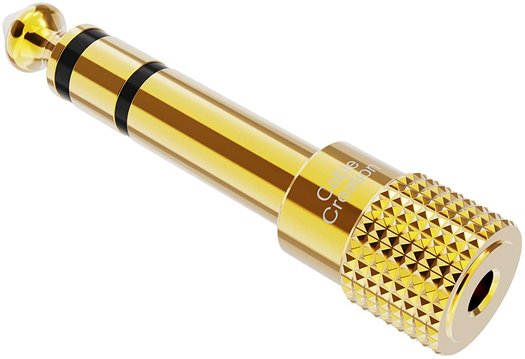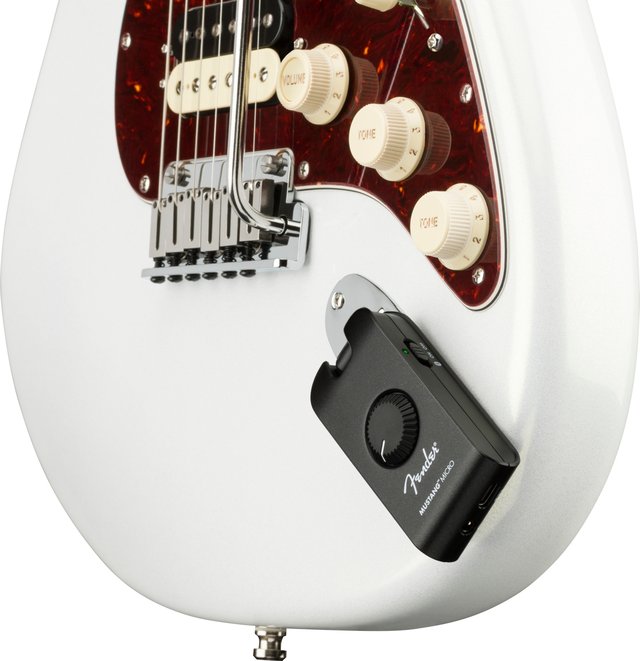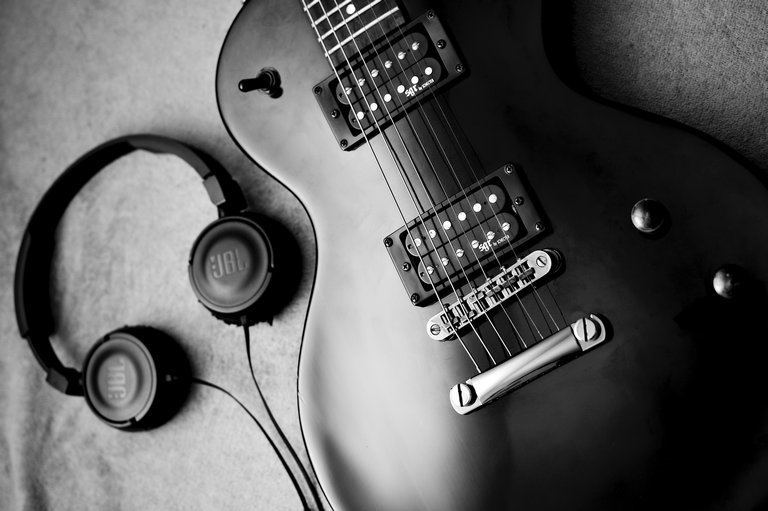There can be multiple reasons why you would want to play your guitar with headphones. Whether you’re trying to practice quietly, you’re self-conscious about your playing, or you don’t want to invest in an amp yet. Whatever the reason is, we have got you covered. In this article, we’ll be discussing various methods of playing your guitar through headphones. Along with answering several questions you may have, like using Bluetooth headsets. Keep reading to find out more!
There are multiple ways to play electric guitar with headphones. You can connect the headphone to your amp or buy a small micro-amp, a relatively cheap device that plugs directly into your guitar’s output jack and offers many features. You can also use multi-effect pedals or audio interfaces. Depending on your use-case and future goals, one method might suit you better.
Best Ways To Play Electric Guitar With Headphones
There are several ways to play or practice an electric guitar with headphones. Some methods, like using a headphone amp (or micro-amp), will provide decent sound quality with good-quality headphones. A multi-effect pedal can be a bit more expensive, but you’ll have more options, additional versatility, and better sound quality.
Using an audio interface with PCs may be a bit complicated, but the ability to simulate expensive and bouquet amps and be able to add complicated effects, albeit typically with paid software, will offer virtually unlimited possibilities.
Something like a modeling amp will provide you with great versatility to simulate many amp models and various effects in a portable (practice amp) form factor. Though a bit expensive, they’ll be very suitable for someone very serious about electric guitars.
Plug Your Headphone Into the Guitar Amp
The most straightforward method to play an electric guitar through your headphones is to plug it into the amp. This way you’ll not have to buy anything new. The caveat is you’ve got to have an amp with a headphone jack. As soon as you plug the headphones in, the amp’s speakers stop firing. It is a great method to practice without disturbing others, and you get to use all the features and effects of your amp without having to spend a dime (considering you already have a headphone).
Ensure that your amp has a headphone jack which is usually 1/8th inch or 3.5mm and can directly connect to a headphone. Some amps may have a larger jack which is 1/4th inch or 6.35mm, the same as the guitar output jack. To connect your headphones to this, you’ll need a 1/4th-to-1/8th-inch adapter like the following:

Not all amps have the headphone jack, but many may have a line-out jack which is almost always 1/4th inch or 6.35mm. You may be able to connect your headphone to this jack using the above adapter.
If your amp only has a line-out jack, remember to check your manual before plugging in the headphones. Some amps may send the signal from the preamp to this socket, in which case the output would not sound good. It might even output a much higher power signal, in which case the headphones or, even worse, the amp may burn.
Double-check your amp’s manual before proceeding.
Pros
- Quick and easy method
- No need to buy anything except for the adapter
Cons
- Not all amps have a headphone jack
- Sound quality may not be good depending on the amp
Verdict
Use the amp if you have one that has a headphone jack and you’re satisfied with the sound quality. If you don’t have an amp yet or it doesn’t have an output jack, you can either buy a new amp or, if you’ll likely be playing through your headphones most of the time, choose another option.
Always start with 0 volume and gradually increase to when you feel comfortable with sound output. Very high volume may damage your ears.
Use a Multi-Effects Pedal To Connect Your Headphone
Multi-effect units are a fun way to produce decent sound output at an affordable price. You can buy something that lets you model or simulate different guitar amps and various effects. Since these are small and relatively inexpensive devices (around $100), you cannot expect very high sound quality. But for most people practicing at home, these effect pedals would be a very good choice for playing through headphones.
A typical unit like a Vox Modeling Guitar Multi-Effects Pedal offers both Clean and Distortion channels and effects like Reverb, Chorus, Delay, Wah-Wah, etc., along with Tube-Amp modeling, among other things. If you’re looking to find an inexpensive alternative to buying an amp, this could be very well worth your money and then some. You will save money on the amp and not have to buy several common effect-pedals.
You can even plug these into a PA system for larger performances.
Pros
- Ability to model many amp models
- Variety of effects in one pedal
- Great value for money device for beginners as well as intermediates
Cons
- Some people, usually professionals, do not like all-in-one pedals because they feel they are decent at every effect but not particularly great at any one thing
- A bit expensive just to play guitar with headphones
Verdict
Get it if you’re interested in the sound of various guitar models and effects. These pedals require some learning and tinkering to get your desired sond, so if you just want something to play the guitar through your headphones without an amp, there are better and cheaper alternatives.
Use a Micro-Amp (Headphone Amp) To Connect Your Headphone

This is another excellent and cheaper (around $50) alternative to connect your headphones to the guitar without an amp. These micro-amps are pocket-sized devices that need batteries to run and hook right into the guitar’s output jack. These headphone amps offer decent sound quality with good headphones and many effects. Vox offers various models that have different tonal characteristics. For example, you can find one for Rock, Blues, Clean, and Metal, and each model is slightly more suitable for a specific music genre. There is one available for bass guitars as well for those who play bass guitars.
Another micro-amp – the Valeton Rushead Max offers three amp models from clean to heavy metal, a variety of effects, and a rechargeable battery inside (you can use a USB phone charger for charging).
Some micro-amps allow you to plug in your phone via a 1/8th inch AUX cable to jam to a backing track.
Pros
- Very small and portable – you can fit them in your pocket
- Variety of effects and amps model in the smallest form factor
- Can jam with backing track via AUX input cable
- Great for people who are constantly traveling
- Very inexpensive and great value for money device for beginners (some professionals use them too)
Cons
- Sound quality may not be the greatest
Verdict
One of the best investments you can make for quiet practice sessions or as a constant traveler. But, if you wish to use these primarily for home practice and can shell out some extra money, there are better, more powerful, and versatile alternatives.
Use a Modeling Practice Amp To Connect Your Headphone
Practice amps are great for bedroom practice at lower volumes. They are like a smaller version of a guitar amp and come with loudspeakers. You can play your guitar through the speakers or plug in headphones for quieter practice. Many of these amps have sufficiently high power output (around 50 watts) and are loud enough even for small, intimate gigs.
Many of these practice amps have amp modeling that simulates other famous guitar amps, and come with various common effects. What separates these from the micro-amps and multi-effect pedals is the EQ controls that are on par with full-fledged amps, though the higher-end multi-fx pedals also come with decent EQs. The sound quality is also very adequate for most people.
Pros
- Good value for money amp
- feature-rich and versatile
- Ability to play with or without headphones
Cons
- A bit expensive ($150-$300)
- They do everything alright but are not particularly great at anything
Verdict
Great for practice. Besides their versatility and convenience, these practice amps can help you try out a bunch of different amps to figure out what you like. If you’re starting out and want something cheaper just to plug in your headphones, there are other alternatives.
Use an Audio Interface To Connect With a PC/Phone and Then to a Headphone
An audio interface is a small and cheap (around $50) device that lets you connect your guitar to your PC/Mac/Phone. On the PC, you’ll need a software called the Digital Audio Workstation, or DAW for short, to edit, modify and record the audio. The DAW is a vast topic on its own, but in short, they let you do virtually anything you can do with standalone amps, effect pedals, or pretty much anything you can think of. You can model guitars (and do it very well and probably better than most other options), add any effect under the sun, and a bunch of other stuff.
You can play the guitar through your PC speakers (it wouldn’t sound good, though) or through your headphones. The caveat is many of these DAWs are paid software, and they require plugins (or software that extends their features) to do many things like modeling guitar amps, etc. many of these plugins may be paid software.
Great quality freeware software and plugins are available, but you’ll have to do some digging. With a free setup, you can do a great deal of modeling and effects, with your only cost being that of the audio interface.
Another issue some not-so-tech-savvy people may face is that these softwares may be challenging to use. But, if you’re someone who would want to record tracks in the future, this would be a great option.
Pros
- Great sound quality
- Excellent versatility and power to model virtually any amp and add any effect
- Affordable in case you use free or inexpensive DAWs and plugins
- Ability to record
Cons
- It may be complicated for some people
- May need a decently powered PC for certain types of simulation and effects
- Lot of work if you just want to play guitar through your headphones
Verdict
The most powerful and versatile option for tech-savvy people looking to record music tracks. There are other simpler alternatives if you’re looking for a quick and easy way to play your guitar through headphones and do not care about recording.
Are There Electric Guitars With Headphone Jacks?
Not one that I have personally seen or heard of. But there might be. However, I’d suggest staying away from such niche guitars. Most big companies do not make such guitars, and for a good reason. You can just buy a cheap micro-amp that fits right into the output jack, and now you have a guitar that pretty much has a headphone jack. And it is a guitar that you have or like and not some obscure practice guitar that might sound terrible.
Can I Connect an Electric Guitar to Bluetooth Headphones?
Unfortunately, Bluetooth headphones have latency which is not a big factor when you’re listening to music that is a continuous stream. But the lag would make guitar practice annoying in the best case and almost impossible in the worst. The latency means there will be a lag when you pluck a note before you hear it. It may make practice feel awkward and off for most people. Newer Bluetooth headphones have lower latency but are still too much for comfortable guitar practice.
If you’re still adamant, do the following:
- Connect your guitar to your laptop/phone through an audio interface
- Pair your Bluetooth headset with your laptop/phone
- Enjoy (or not!) your guitar playing through Bluetooth technology
Be warned, unless you have a very low latency headset, you will have a hard time!
Other Related Questions
Can I Connect the Headphone Directly to the Guitar’s Output Jack?
No, the guitar's output jack doesn't provide enough power to drive headphones. They are also different sizes - headphones have a 1/8th inch or 3.5mm jack, while guitars have a 1/4th inch or 6.35mm jack. I've heard some guitars with active pickups (that take 9v batteries) can drive headphones directly, but the sound quality is not good enough. The impedance of these devices is different, and guitars need some external tone shaping through an amp of any sort to sound good.
Do All Amps Have a Headphone Jack?
Almost all newer practice amps have a 3.5mm or 1/8th-inch headphone jack, while many other solid-state amps have a 1/4th inch or 6.35mm audio output jack. Most tube amps do not have any headphone jack, though.


